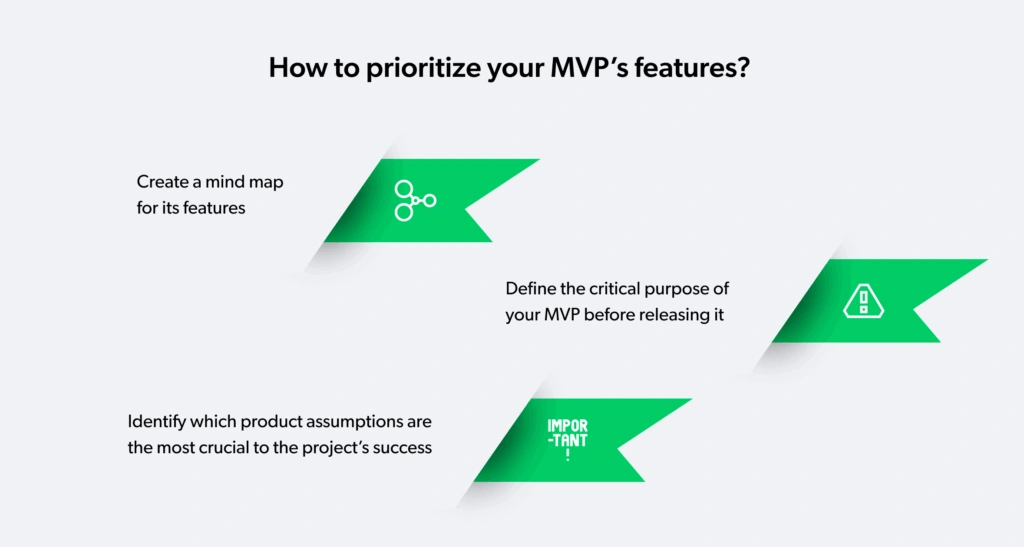Antoine de Saint-Exupery once said that perfection is achieved not when there is nothing more to add, but when there is nothing left to take away. In MVP development, that’s especially true. The problem of overfilling the “probe” of a future application with too many features is not always obvious, but in 9 out of 10 cases, it leads to financial losses and squandered business opportunities. In this article, we’ll explain what an MVP is, find out why it’s important to detect functionality overloading and we’ll discuss how to prevent the pilot version of an app from getting all cluttered up.
What is an MVP and why do you need it?
MVP (sometimes confused with Minimum Valuable Product) is a Minimum Viable Product that allows you to get meaningful feedback from your users. In other words, this is a hypothesis application, which launches with your expectation of a confirmation or refutation. The main purpose of an MVP is to collect valuable information, it’s not for conquering the market or for generating profit right away. Based on the information the MVP gathers, your team will either get the green light to dive into the development of a full-fledged project or the team will switch to another hypothesis. An MVP’s initial failure doesn’t always have to lead to a complete rethinking of the idea and the approaches to its implementation. Thoughtful analysis of the feedback gained can reveal the shortcomings of conceptually successful MVP features and, after making some changes, you can return to testing the updated hypothesis.
Sometimes the purpose of building an MVP isn’t so obvious. Remember, an idea is not the target result. Thus, stay patient and trust the results of a released prototype, albeit with minimal functionality. By running MVP, you can:
- Save money by not investing in a project that you discovered to be non-viable early on
- Check to make sure your product actually interests your potential users
- With the help of iterations, find out the best direction for optimal development
- Collect a base of potential customers and find early adopters of your product
Building a Minimum Viable Product (MVP) is like packing for a journey. You want to make sure you have everything you need, but overloading your backpack can slow you down and leave you exhausted before you even begin.
Sergei Zagriychuk, Head of Java Competency Center
How to detect MVP feature overloads?
The lack of understanding the strategic importance of MVP testing is not the only problem you encounter when developing a project. Sometimes we observe a completely opposite situation: the client wants to implement a significant part of the planned features or sometimes all of them. This approach completely violates the very essence of MVP and often leads to:
- A significant delay in time-to-market
- Doubling the workload by having to change the additional MVP features that didn’t meet expectations
- Budgets run down faster and you’re not meeting your targets
Any application that claims to be an MVP should first of all be lightweight and developed quickly, so a 2-3 month time period is reasonable. If the team feels that 2-3 months will not be enough time to implement the intended functionality, then it’s best to revise the priorities or the MVP’s terms of reference.
Another indicator of project overload with unnecessary MVP features can be tasks that are excessively large. Basically, we recommended spending no more than 3-4 days to complete an average task. In some special cases, the time can rise up to 8-10 business days. If you have more and more of these “special cases” in your schedule, then it’s time to think about breaking them down into smaller pieces. If that’s not possible, then think about the necessity to perform this particular task in the MVP’s creation.
Here’s another good way to look at it: ask how many tasks you need to complete so that the goal of building an MVP is achieved. If there’s no exact answer and if it’s rather difficult to formulate an answer in general; then it’s the first sign of trouble. Optimized MVPs must always stay clear and focused. Without a precise objective, you won’t be able to realize when you’ve crossed the line and have begun overstuffing your MVP with too many features.
Make sure you genuinely know which features are required to meet the needs of your key user group. Before you start building an MVP, you should have a really good understanding of who your key end-users are. The very rationale behind creating an MVP is that it should allow you to verify your key assumptions with a particular client group, as opposed to trying to cater to the needs of all of your potential clients. In the cases where you widen your target audience too much it immediately gets you into the trap of adding and having too many MVP features.
How to prioritize your MVP’s features?
The simple answer is “figure out what you want to achieve and prioritize your features”. Never try to make your MVP 100% “perfect” – it’s better to just focus only on the functionalities that are absolutely necessary.
We’ll provide a few recommendations on how you can slim down your MVP that’s been overloaded with too many features:

Identify which product assumptions are the most crucial to the project’s success
When building a Minimum Viable Product (MVP), it’s essential to identify which product assumptions are the most critical to the project’s success. To do this, start by considering the key actions you expect your users to take when interacting with the product. Then, evaluate each product assumption and determine whether it’s necessary to meet these criteria.
Removing non-critical MVP features can help simplify the product development process and reduce the time and resources needed for launch. By focusing only on the essential features, you can create a functional MVP that meets the needs of your target audience while still allowing room for iteration and improvement. This approach can also help you to get your product to market quicker, which enables you to gather feedback and refine your offering based on real-world user behavior faster.
Define the critical purpose of your MVP before releasing it
When planning to release an MVP, it’s crucial to define its critical purpose. This means asking yourself why you need the MVP in the first place. It’s important to be as specific as possible. Avoid making vague formulations that can lead you in the wrong direction.
For instance, you might need an MVP to test a product assumption or validate a business model. Alternatively, you may be looking to gain traction early, generate user feedback or create a proof-of-concept. In all cases, you should clearly define the purpose of your MVP before committing any significant time or resources to its development.
By defining the critical purpose of your MVP, you can focus your efforts on building only the most essential features that will help you to achieve your goals. This approach can help you create a more efficient and effective MVP, reducing the risk of wasting resources on unnecessary features or functionalities. Ultimately, the more specific you are about the purpose of your MVP, the greater the likelihood is of achieving success.
Create a mind map for its features
When creating an MVP, it’s important to put yourself in your client’s shoes and think about the features they need. One way to organize your thoughts is to create a mind map for features. Start by writing down the steps your client will take when using the product, and then identify the features that are necessary for each step along the way.
Next, figure out which features are essential to the project’s success and build a hierarchical table of subtasks and support features. This will help you prioritize and focus on the most important aspects of the product.
To make your mind map more representational and effective, you can use different online tools such as mind-mapping software, whiteboards, or sticky notes. However, a traditional pen and paper can work just as well.
By using a mind map to organize your features, you can visualize the flow of the product and identify any missing or unnecessary features. This approach can help you create a streamlined MVP that meets the needs of your target audience while still leaving room for future development and expansion.
Conclusion
In conclusion, if you’re tempted to overload your MVP with every feature under the sun, just remember that less is often more. Sure, you could add a “find me a date” button to your gardening app, but do you really want to be responsible for the next Tinder? Stick to your essential, basic MVP features and resist the urge to become a feature-hoarder. Your users will thank you, and your development team might even buy you a drink (or two). Remember, the goal of your MVP is not to be a jack-of-all-trades, but a master of just the essentials. So, keep it simple, keep it focused, and keep on innovating!









